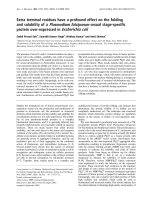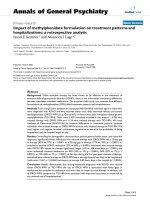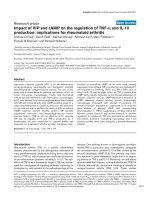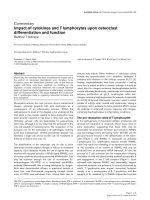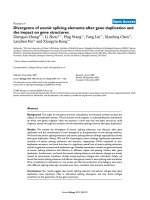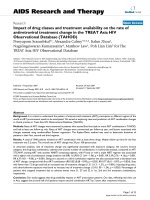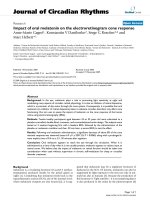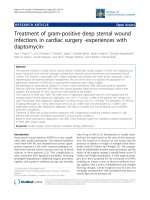Báo cáo y học: "Impact of IL8 and IL8-Receptor alpha polymorphisms on the genetics of bronchial asthma and severe RSV infections" doc
Bạn đang xem bản rút gọn của tài liệu. Xem và tải ngay bản đầy đủ của tài liệu tại đây (244.91 KB, 6 trang )
BioMed Central
Page 1 of 6
(page number not for citation purposes)
Clinical and Molecular Allergy
Open Access
Research
Impact of IL8 and IL8-Receptor alpha polymorphisms on the genetics
of bronchial asthma and severe RSV infections
Beena Puthothu
1
, Marcus Krueger
1
, Jessica Heinze
1
, Johannes Forster
1,2
and
Andrea Heinzmann*
1
Address:
1
University Children's Hospital, University of Freiburg, Mathildenstrasse 1, D-79106 Freiburg, Germany and
2
St. Josefhospital, Sautier
Str. 1, D-79104 Freiburg, Germany
Email: Beena Puthothu - ; Marcus Krueger - ; Jessica Heinze - ;
Johannes Forster - ; Andrea Heinzmann* -
* Corresponding author
Abstract
Background: Interleukin 8 (IL8) belongs to the family of chemokines. It mediates the activation
and migration of neutrophils from peripheral blood into tissue and hereby plays a pivotal role in
the initiation of inflammation. Thus it is important in inflammatory lung diseases like bronchial
asthma or severe infections by Respiratory Syncytial Virus (RSV). IL8 acts through binding to the
IL8-Receptor alpha (IL8RA). For both genes association with asthma has been described. In
addition, IL8 has been found in association with RSV bronchiolitis. The aim of our study was to test
both genes for association with asthma and severe RSV infections. In addition we were interested
in whether a common genetic background of both diseases exists in regards to these genes.
Methods: We genotyped the two IL8 promotor polymorphisms -251A/T and -781C/T and the
three amino acid variants M31R, S276T and R335C in IL8RA on 322 children with asthma, 131
infants with severe RSV associated diseases and 270 controls. Statistical analyses made use of the
Armitage's trend test for single polymorphisms and FAMHAP for calculations of haplotypes.
Results: We found association of the IL8 polymorphism -781C/T as well as IL8 haplotypes with
asthma (p = 0.011 and p = 0.036, respectively). In addition, direct comparison of the asthmatic
population with the RSV population revealed significant differences, both for -781C/T alone (p =
0.034) and IL8 haplotypes (p = 0.005). The amino acid variants in IL8RA were evenly distributed in
between all three populations.
Conclusion: We conclude from our data that IL8 might play a role in the genetic predisposition
to asthma and that these effects are different or even opposite to the effects on severe RSV
diseases. Furthermore, IL8RA is unlikely to play a major role in the genetics of either disease.
Background
Interleukin 8 (IL8) is a member of the chemokine family
and is produced by a wide range of cell types like mono-
cytes, macrophages, fibroblasts and ceratinocytes. It pri-
marily mediates the activation and migration of
neutrophils from peripheral blood into tissue and is
involved in the initiation and amplification of inflamma-
tory processes, which occur in the human immune system
Published: 17 February 2006
Clinical and Molecular Allergy 2006, 4:2 doi:10.1186/1476-7961-4-2
Received: 27 December 2005
Accepted: 17 February 2006
This article is available from: />© 2006 Puthothu et al; licensee BioMed Central Ltd.
This is an Open Access article distributed under the terms of the Creative Commons Attribution License ( />),
which permits unrestricted use, distribution, and reproduction in any medium, provided the original work is properly cited.
Clinical and Molecular Allergy 2006, 4:2 />Page 2 of 6
(page number not for citation purposes)
in response to a wide variety of pathogens [1]. Thus IL8
play an important role in inflammatory lung diseases like
bronchial asthma or severe infections caused by respira-
tory syncytial virus (RSV).
RSV, a single-stranded RNA virus, is involved in at least
70% of cases of infectious infantile bronchiolitis and has
been repetitively linked to asthma. It has been hypothe-
sized that severe RSV infection in infancy might lead to
the development of recurrent wheezing and/or bronchial
asthma [2,3], and consequently a common genetic back-
ground of both diseases has been discussed [4]. According
to the current evidence, genetic and environmental factors
determine the type of immune response to RSV infection.
Furthermore, this response may affect the development of
control mechanisms in the regulation of airway diseases,
mainly bronchial asthma.
Increased concentrations of IL8 have been described in
the bronchoalveolar fluid and sputum of asthmatic
patients [5]. In addition, repeated administration of IL8
into the airways induces bronchial hyperreactivity in
guinea pigs [6,7]. Genetic association of IL8 has been
described with asthma [8] and RSV bronchiolitis [9,10].
IL8 binds with high affinity to two different receptors: IL8
receptor alpha (IL8RA, CXCR1) and beta (IL8RB, CXCR2).
These closely related proteins are members of the super-
family of receptors, which couple to guanine nucleotide
binding proteins. IL8RA is localized on chromosome
2q35 [11], where linkage to total serum IgE levels in asth-
matics has been described [12]. In addition, association of
IL8RA polymorphisms has recently been described with
asthma and chronic obstructive pulmonary disease [13].
We were interested in the relationship between severe RSV
infection and/or bronchial asthma and IL8 and IL8RA pol-
ymorphisms in the German population. We chose to
study two IL8 promoter polymorphisms (-251A/T and -
781C/T) and three amino acid variants in IL8RA (M31R,
S276T and R335C), which are located in the N-terminus
of the protein, in the third extracellular loop and in the C-
terminus of the protein respectively. The selection of the
IL8 polymorphisms was based on previous studies in our
asthmatic and control populations, in which these poly-
morphisms were shown to be most informative [8].
Materials and methods
Subjects
Asthmatic population
322 children with bronchial asthma (aged 5 to 18 years)
were recruited from the South-Western part of Germany
between July 2000 and January 2005. All probands were
characterized at the University Children's Hospital,
Freiburg, Germany using a standardized clinical protocol.
An extended medical history was recorded including the
occurrence and duration of wheezing symptoms; previous
and acute medications; severity of previous asthma
attacks; previous allergic rhinitis or conjunctivitis; atopic
dermatitis and any family history of allergic diseases.
The diagnosis was based on a clear-cut history of asth-
matic symptoms; the use of anti-asthmatic medication
and the presence of bronchial hyper-reactivity. The anti-
asthmatic drugs included typical betamimetics like salb-
utamol and standard corticosteroids used in asthma treat-
ment like budesonide. Bronchial hyper-reactivity was
defined as a fall in forced respiratory volume in one sec-
ond (FEV1) by at least 15% in histamine testing or exer-
cise provocation, using standard protocols [14]. The exact
recruitment procedure has been described in detail previ-
ously [15].
Population of children with severe RSV infection
This population was recruited at the University Children's
Hospital, Freiburg, Germany and also in the Community
Children's Hospital, St. Josef's Hospital, Freiburg. Infants
and children were eligible when hospitalized due to RSV
infection between September 1998 and March 2005 at an
age of less than 2 years. RSV infection was detected by
antigen test and/or RSV-specific PCR [16]. According to
the case definition, children had symptoms of bronchioli-
tis, for example wheezing and tachypnoe and needed
either supplementary oxygen and/or gavage feeding and/
or intravenous fluids. Children with congenital heart
defects, immune deficiency or chromosomal aberrations
were excluded. DNA samples were collected either by
Table 1: Frequency and HWE of the polymorphisms within the three populations.
Polymorphism Asthma Frequency HWE RSV Frequency HWE Controls Frequency HWE
IL8 rs4073 (-251A/T) 0.441 0.469 0.470 0.241 0.493 0.223
IL8 rs2227306 (-781C/T) 0.618 0.708 0.540 0.914 0.543 0.242
IL8RA rs16858811 (M31R) 0.969 1.000 0.974 1.000 0.954 1.000
IL8RA rs16858809 (S276T) 0.933 1.000 0.948 1.000 0.944 1.000
IL8RA rs16858808 (R335C) 0.967 1.000 0.974 1.000 0.954 0.441
Results of genotyping of the IL8 and IL8RA variants on the three populations. The frequency is given for the wildtype allele. Also given is the p-value
for the Hardy Weinberg Equilibrium (HWE) as calculated by Finetti.
Clinical and Molecular Allergy 2006, 4:2 />Page 3 of 6
(page number not for citation purposes)
blood taking or buccal smears with sterile cotton sticks. In
total 131 children were included in this study.
Control population
270 randomly chosen probands, aged 19 to 40 years,
served as controls. They originated from the same area in
the South-Western part of Germany. No medical history
was taken and no medical testing was performed on con-
trols.
Genotyping
DNA was extracted from peripheral blood leucocytes or
buccal smears following standard protocols and column
purified (DNA midikit, Qiagen, Germany). The two IL8
polymorphisms (-251A/T and -781C/T) were typed as
described previously [8].
The three IL8R polymorphisms were typed by means of
restriction fragment length polymorphism (RFLP):
Met31Arg (rs16858811) was typed using the primer pair
5'-TGAAGATTACAGGCCCTGTA-3' and 5'-AAATC-
CAGCCATTCACCTTG-3'. Following PCR, the product
was digested with two units of BglI (Fermentas) at 37°
over night and the fragments were resolved on a 4% agar-
ose gel.
Ser276Thr (rs16858809) was typed using the primer pair
5'-TCACCCTGCGTACACTGTTT-3' and 5'-GCCAA-
GAACTCCTTGCTGAC-3. Following PCR, the product was
digested with one unit of Alw261 (Fermentas) at 37°C
over night and the fragments were resolved on a 4% agar-
ose gel.
Arg335Cys (rs16858808) was typed using the primer pair
5'-AGGAGTTCTTGGCACGTGAT -3' and 5'-AATGATGGT-
GCTTCGTTTCC-3'. Following PCR, the product was
digested with one unit of DpnII (NEB) at 37°C over night
and the fragments were resolved on 4% agarose gel.
Sequencing
For each polymorphism, three controls (homozygous
wild type, heterozygous and homozygous mutation) were
sequenced by the dideoxy chain termination method
[17], using the Big Dye Terminator cycle sequencing kit on
an ABI 310 sequencer (Applied Biosystems). All the fol-
lowing studies included these reference individuals.
Statistical analysis
Association analysis was performed for each polymor-
phism using Armitage's Trend Test. This test takes into
account the individuals' genotypes rather than just the
alleles, following the guidelines given by Sasieni [18], as
implemented in the program Finetti (Thomas F. Wienker,
unpublished data; />and />Hardy Weinberg equilibrium (HWE) was calculated for
each polymorphism in all three populations using also
the program Finetti. In addition to analyses based on sin-
gle polymorphisms, we performed haplotype frequency
estimations using the program FAMHAP [19]. The extent
of linkage disequilibrium between polymorphisms has
been calculated by Arlequin.
Approval
The collection of blood and the experimental procedures
were approved by the Ethical Committee of the University
of Freiburg. A statement of informed consent was signed
by all participants; or in the case of children, signed by
their parents.
Results
Genotyping
Five polymorphisms, two IL8 and three IL8RA polymor-
phisms, were typed on 131 children with severe RSV infec-
tion, 270 controls and 322 asthmatic children. The allelic
frequencies of the polymorphisms in the three popula-
tions and the Hardy Weinberg equilibrium are given in
table 1. All polymorphisms were in Hardy Weinberg equi-
librium in all populations.
Association studies
The genotype distribution in the populations and the p-
values for association, obtained by Armitage's Trend Test,
are listed in table 2. An association was observed between
asthma and the promoter polymorphism -781C/T in IL8
Table 2: Genotype distribution and p-values for association
Polymorphism Genotype distribution p-values for association
Asthma RSV Controls Asthma- Controls RSV- Controls Asthma- RSV
IL8 rs4073 (-251A/T) 64; 148; 101 26; 73; 34 70; 124; 74 0.087 0.550 0.425
IL8 rs2227306 (-781C/T) 123; 147; 48 37; 62; 27 84; 124; 61 0.011 0.937 0.034
IL8RA rs16858811 (M31R) 299; 20; 0 128; 7; 0 245; 25; 0 0.174 0.152 0.655
IL8RA rs16858809 (S276T) 239; 30; 0 121; 14; 0 121; 14;0 0.409 0.812 0.376
IL8RA rs16858808 (R335C) 298; 21; 0 127; 7; 0 246; 23; 1 0.239 0.171 0.584
The genotype distribution within the three different populations is given in the following order: homozygous wildtype, heterozygous and
homozygous mutation. Also listed are the p-values for association with the diseases as calculated by the Armitage's trend test.
Clinical and Molecular Allergy 2006, 4:2 />Page 4 of 6
(page number not for citation purposes)
(p = 0.011). When comparing children with asthma to
children with severe RSV infection, a significant different
allelic distribution was observed for the same polymor-
phism (p = 0.0342). The other evaluated polymorphisms
showed no association with bronchial asthma or severe
RSV infection.
The two polymorphisms within IL8 were in very tight
linkage disequilibrium in all populations (p = 0.00000 for
all possible pairs). Thus we did not perform Bonferroni
correction for multiple testing as it would be far too con-
servative in this case. In IL8RA M31R and R35C were
transmitted together (p < 0.0001 for all populations).
Haplotype analyses
The haplotype pattern in all populations is given in table
3. IL8 haplotypes showed weak association with asthma
(p = 0.036). Furthermore, haplotypes of IL8 were signifi-
cantly differently distributed between asthmatics and chil-
dren with severe RSV infection (p = 0.005; see table 4). In
contrast, no effect was seen with IL8RA haplotypes on
either disease.
Discussion
So far, only few studies have investigated the impact of
polymorphisms within the IL8 signaling pathway on the
genetic background of severe RSV associated diseases or
bronchial asthma. The IL8 pathway includes IL8 itself, its
two receptor chains IL8RA and IL8RB and its degradative
enzyme aminopeptidase N [20]. In a previous study, we
have shown that IL8 polymorphisms are in association
with bronchial asthma in the German population using
230 asthmatic children and 270 randomly chosen con-
trols [8]. Furthermore, we hypothesized that polymor-
phisms within IL8 have opposite effects on the
development of asthma and severe RSV infections. The
hypothesis was based on the observation that the -251T
allele was more common in patients with asthma than in
controls. In contrast, two studies from Hull and col-
leagues have demonstrated that the opposite allele, that is
-251A, is associated with severe RSV infection in the Eng-
lish population [9,10].
Thus the first aim of the current study was to test whether
our initial hypothesis of an opposite role of IL8 polymor-
phisms on asthma and RSV infections holds in a popula-
tion of German children with severe RSV associated
diseases. Second, we wanted to verify the association
between bronchial asthma and IL8 polymorphisms in an
extended asthmatic population (increased by 90 asth-
matic children to 320 probands). Thirdly, we extended
our investigation to include IL8RA as recently association
of asthma and chronic obstructive pulmonary disease
with this gene has been reported in another German sam-
ples [13].
In the here presented study, the polymorphisms -251A/T
and -781C/T within IL8 showed no association with
severe RSV associated diseases - neither in analyses of sin-
gle polymorphisms nor in haplotype analyses. This might
suggest that IL8 does not play a major role in the develop-
ment of severe RSV infections in the German population.
These findings are in contrast to the above mentioned
studies of Hull et al. [9,10]. The discrepancy could be due
to several reasons: The infants included in the study of
Hull et al. were younger than in our study. Furthermore,
the inclusion criteria differed slightly between both stud-
ies, for example, Hull and colleagues included children
with pre-existing heart diseases, whereas we excluded
those children. Finally, though the English and German
population represent both Caucasians it is well known
that the genetic predisposition to allergic diseases are at
least partially different between Germans and English
people [21].
The association between bronchial asthma and -781C/T
within IL8 could be confirmed in an extended asthmatic
population (p = 0.011), whereas the association with the
second IL8 polymorphism -251A/T and asthma became
weaker and was no longer statistically significant (p =
0.087). This might be in accordance to one study, show-
ing that -251A/T has no functional impact, whereas the
base pair substitution C to T at position -781 within the
IL8 promotor enhances the binding of transcription fac-
tors and thus is probably more important in the genetic
regulation of IL8 expression [22].
Table 4: Results of the haplotype analyses using FAMHAP.
Asthma-Controls RSV-Controls RSV-Asthma
IL8 0.036 0.180 0.005
IL8RA 0.448 0.729 0.724
Table 3: Frequency of the haplotype within the three
populations.
Haplotype Asthma RSV Controls
IL8 1 1 0.061 0.029 0.038
1 2 0.380 0.443 0.455
2 1 0.558 0.503 0.504
2 2 0.002 0.024 0.004
IL8RA 1 1 1 0.904 0.922 0.897
1 2 1 0.065 0.052 0.055
2 1 2 0.031 0.026 0.044
Number 1 refers to the wildtype allele, 2 to the variant allele.
Clinical and Molecular Allergy 2006, 4:2 />Page 5 of 6
(page number not for citation purposes)
Furthermore, a direct comparison of the asthmatic popu-
lation with the RSV population revealed significant differ-
ences, both for -781C/T alone (p = 0.034) as well as in the
haplotype analyses (p = 0.005). These results may support
our initial hypothesis, that polymorphisms within IL8
have opposite effects in the pathophysiology of asthma
and RSV associated diseases. However, one should notice,
that the allelic frequencies of the polymorphisms did not
markedly differ between controls and children with severe
RSV infections. Thus the positive association might
merely reflect the fact that the genotype frequencies in
asthmatics differ from controls.
In contrast to Stemmler et al, who found that the IL8RA
polymorphisms M13R and R335C were significantly asso-
ciated with bronchial asthma [13], we found no associa-
tion of these polymorphisms neither with asthma nor
severe RSV associated diseases. Again the conflicting
results might be due to different inclusion criteria. The
study by Stemmler et al. used 68 adult patients and 130
children with asthma whereas we used exclusively chil-
dren with asthma. The "adult phenotype" of asthma is
quite different from the asthmatic phenotype in children.
For example pediatric asthma is much more often allergic
than asthma in adults. Thus it might not be surprising that
the genetic background of asthma differs between adults
and children [23]. Furthermore, the size of our asthmatic
study population was larger than the population of
Stemmler et al. (198 asthmatic patients versus 320
patients). Thus the significant result in their study might
just reflect a type 1 error. However, as the risk factor con-
ferred by a single gene is quite small in complex genetic
diseases like asthma, it is also possible that we missed true
association in our population due to a type 2 error.
Conclusion
We conclude from our data, that IL8 might play a role in
the genetic predisposition to bronchial asthma and that
these effects are different, or maybe even opposite to the
effects of the same polymorphisms on severe RSV associ-
ated diseases. In contrast IL8RA polymorphisms do not
play a major role, neither in the development of severe
RSV infections nor in asthma.
Competing interests
The author(s) declare that they have no competing inter-
ests.
Authors' contributions
BP performed genotyping and sequencing of IL8 poly-
morphisms as well as the statistical analyses and drafted
the manuscript.
MK participated in the clinical design of the study and the
recruitment of the RSV population.
JH performed genotyping and sequencing of IL8RA poly-
morphisms
JF participated in the clinical design of the study.
AH conceived and coordinated the study and helped to
draft the manuscript.
All authors have read and approved the final manuscript.
Acknowledgements
This project was supported by grants from the Deutsche Forschungsge-
meinschaft (DFG HE 3123/3-1 and DFG HE 3123/4-2). The recruitment of
asthmatic children was partially supported by a grant from the NIH (NIH
R01 HL66533-01).
References
1. Harada A, Sekido N, Akahoshi T, Wada T, Mukaida N, Matsushima K:
Essential involvement of interleukin-8 (IL8) in acute inflam-
mation. J Leukoc Biol 1994, 56:559-564.
2. Sigurs N, Gustafsson PM, Bjarnason R, Lundberg F, Schmidt S, Sigurb-
ergsson F, Kjellman B: Severe respiratory syncytial virus bron-
chiolitis in infancy and asthma and allergy at age 13. Am J
Respir Crit Care Med 2005, 171:137-41.
3. Sigurs N, Bjarnason R, Sigurbergsson F, Kjellman B: Respiratory
syncytial virus bronchiolitis in infancy is an important risk
factor for asthma and allergy at age 7. Am J Respir Crit Care Med
2000, 161:1501-7.
4. Stein RT, Sherrill D, Morgan W, Holberg CJ, Halonen M, Taussig LM,
Wright AL, Martinez FD: Respiratory syncytial virus in early life
and risk of wheeze and allergy by age 13 years. Lancet 1999,
354:541-5.
5. Norzila MZ, Fakes K, Henry RL, Simpson J, Gibson PG: Interleukin-
8 secretion and neutrophil recruitment accompanies
induced sputum eosinophil activation in children with acute
asthma. Am J Respir Crit Care Med 2000, 161:769-74.
6. Fujimura M, Xiu Q, Tsujiura M, Tachibana H, Myou S, Matsuda T, Mat-
sushima K: Role of leukotriene B4 in bronchial hyperrespon-
siveness induced by interleukin-8. Eur Respir J 1998, 11:306-11.
7. Xiu Q, Fujimura M, Nomura M, Saito M, Matsuda T, Akao N, Kondo
K, Matsushima K: Bronchial hyperresponsiveness and airway
neutrophil accumulation induced by interleukin-8 and the
effect of the thromboxane A2 antagonist S-1452 in guinea-
pigs. Clin Exp Allergy 1995, 25:51-9.
8. Heinzmann A, Ahlert I, Kurz T, Berner R, Deichmann KA: Associa-
tion study suggests opposite effects of polymorphisms within
IL8 on bronchial asthma and respiratory syncytial virus bron-
chiolitis. J Allergy Clin Immunol 2004, 114:671-6.
9. Hull J, Ackerman H, Isles K, Usen S, Pinder M, Thomson A,
Kwiatkowski D: Unusual haplotypic structure of IL8, a suscep-
tibility locus for a common respiratory virus. Am J Hum Genet
2001, 69:413-9.
10. Hull J, Thomson A, Kwiatkowski D: Association of respiratory
syncytial virus bronchiolitis with the interleukin 8 gene
region in UK families. Thorax 2000, 55:1023-7.
11. Holmes WE, Lee J, Kuang WJ, Rice GC, Wood WI: Structure and
functional expression of a human interleukin-8 receptor. Sci-
ence 1991, 253:1278-80.
12. Xu J, Postma DS, Howard TD, Koppelman GH, Zheng SL, Stine OC,
Bleecker ER, Meyers DA: Major genes regulating total serum
immunoglobulin E levels in families with asthma. Am J Hum
Genet 2000, 67:1163-73.
13. Stemmler S, Arinir U, Klein W, Rohde G, Hoffjan S, Wirkus N, Rein-
itz-Rademacher K, Bufe A, Schultze-Werninghaus G, Epplen JT: Asso-
ciation of interleukin-8 receptor alpha polymorphisms with
chronic obstructive pulmonary disease and asthma. Genes
Immun 2005, 6:225-30.
14. The International Study of Asthma and Allergies in Childhood
(ISAAC) Steering Committee: Worldwide variation in preva-
lence of symptoms of asthma, allergic rhinoconjunctivitis,
and atopic eczema: ISAAC. Lancet 1998, 351:1225-32.
Publish with BioMed Central and every
scientist can read your work free of charge
"BioMed Central will be the most significant development for
disseminating the results of biomedical research in our lifetime."
Sir Paul Nurse, Cancer Research UK
Your research papers will be:
available free of charge to the entire biomedical community
peer reviewed and published immediately upon acceptance
cited in PubMed and archived on PubMed Central
yours — you keep the copyright
Submit your manuscript here:
/>BioMedcentral
Clinical and Molecular Allergy 2006, 4:2 />Page 6 of 6
(page number not for citation purposes)
15. Heinzmann A, Jerkic SP, Ganter K, Kurz T, Blattmann S, Schuchmann
L, Gerhold K, Berner R, Deichmann KA: Association study of the
variant Arg110Gln in Interleukin-13 with atopic diseases and
juvenile idiopathic arthritis. J Allergy Clin Immunol 2003,
112:735-39.
16. Forster J, Ihorst G, Rieger CH, Stephan V, Frank HD, Gurth H, Berner
R, Rohwedder A, Werchau H, Schumacher M, Tsai T, Petersen G:
Prospective population-based study of viral lower respira-
tory tract infections in children under 3 years of age (the
PRI.DE study). Eur J Pediatr 2004, 163:709-16.
17. Sanger F, Nicklen S, Coulson AR: DNA sequencing with chain-
terminating inhibitors. Biotechnology 1992, 24:104-8.
18. Sasieni PD: From genotypes to genes: doubling the sample
size. Biometrics 1997, 53:1253-61.
19. Becker T, Knapp M: Maximum-likelihood estimation of haplo-
type frequencies in nuclear families. Genet Epidemiol 2004,
27:21-32.
20. Palter SF, Mulayim N, Senturk L, Arici A: Interleukin-8 in the
human. J Clin Endocrinol Metab 2001, 86:2660-7.
21. Kurz T, Strauch K, Heinzmann A, Braun S, Jung M, Ruschendorf F,
Moffatt MF, Cookson WO, Inacio F, Ruffilli A, Nordskov-Hansen G,
Peltre G, Forster J, Kuehr J, Reis A, Wienker TF, Deichmann KA: A
European study on the genetics of mite sensitization. J Allergy
Clin Immunol 2000, 106:925-32.
22. Hacking D, Knight JC, Rockett K, Brown H, Frampton J, Kwiatkowski
DP, Hull J, Udalova IA: Increased in vivo transcription of an IL8
haplotype associated with respiratory syncytial virus disease-
susceptibility. Genes Immun 2004, 5:274-82.
23. Bottema RW, Reijmerink NE, Koppelman GH, Kerkhof M, Postma
DS: Phenotype definition, age, and gender in the genetics of
asthma and atopy. Immunol Allergy Clin North Am 2005, 25:621-39.
